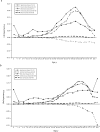Understanding the rapid increase in life expectancy in South Korea
- PMID: 20299661
- PMCID: PMC2853609
- DOI: 10.2105/AJPH.2009.160341
Understanding the rapid increase in life expectancy in South Korea
Abstract
Objectives: We assessed life expectancy increases in the past several decades in South Korea by age and specific causes of death.
Methods: We applied Arriaga's decomposition method to life table data (1970-2005) and mortality statistics (1983-2005) to estimate age- and cause-specific contributions to changes in life expectancy.
Results: Reductions in infant mortality made the largest age-group contribution to the life expectancy increase. Reductions in cardiovascular diseases (particularly stroke and hypertensive diseases) contributed most to longer life expectancy between 1983 and 2005 (30% in males and 28% in females). Lower rates of stomach cancer, liver disease, tuberculosis, and external-cause mortality accounted for 30% of the male and 20% of the female increase in longevity. However, higher mortality from ischemic heart disease, lung and bronchial cancer, colorectal cancer, breast cancer, diabetes, and suicide offset gains by 10% in both genders.
Conclusions: Rapid increases in life expectancy in South Korea were mostly achieved by reductions in infant mortality and in diseases related to infections and blood pressure.
Figures





Similar articles
-
Mind the gaps: age and cause specific mortality and life expectancy in the older population of South Korea and Japan.BMC Public Health. 2020 Jun 1;20(1):819. doi: 10.1186/s12889-020-08978-x. BMC Public Health. 2020. PMID: 32487053 Free PMC article.
-
The changing gender differences in life expectancy in Korea 1970-2005.Soc Sci Med. 2012 Oct;75(7):1280-7. doi: 10.1016/j.socscimed.2012.04.026. Epub 2012 May 23. Soc Sci Med. 2012. PMID: 22739261
-
Mortality inequality in populations with equal life expectancy: Arriaga's decomposition method in SAS, Stata, and Excel.Ann Epidemiol. 2014 Aug;24(8):575-80, 580.e1. doi: 10.1016/j.annepidem.2014.05.006. Epub 2014 May 27. Ann Epidemiol. 2014. PMID: 24970490
-
Impact of suicide mortality on life expectancy in the United States, 2011 and 2015: age and sex decomposition.Public Health. 2020 Feb;179:76-83. doi: 10.1016/j.puhe.2019.09.024. Epub 2019 Nov 14. Public Health. 2020. PMID: 31733510
-
A unifying framework for assessing changes in life expectancy associated with changes in mortality: the case of violent deaths.Theor Popul Biol. 2011 Aug;80(1):38-48. doi: 10.1016/j.tpb.2011.05.002. Epub 2011 May 12. Theor Popul Biol. 2011. PMID: 21609727 Free PMC article. Review.
Cited by
-
The Contribution of Avoidable Mortality to the Life Expectancy Gains in Korea between 1998 and 2017.Int J Environ Res Public Health. 2020 Sep 7;17(18):6499. doi: 10.3390/ijerph17186499. Int J Environ Res Public Health. 2020. PMID: 32906627 Free PMC article.
-
Worldwide impact of economic cycles on suicide trends over 3 decades: differences according to level of development. A mixed effect model study.BMJ Open. 2012 May 14;2(3):e000785. doi: 10.1136/bmjopen-2011-000785. Print 2012. BMJ Open. 2012. PMID: 22586285 Free PMC article.
-
Contributions of the life expectancy gap reduction between urban and rural areas to the increase in overall life expectancy in South Korea from 2000 to 2019.Int J Equity Health. 2023 Jul 28;22(1):141. doi: 10.1186/s12939-023-01960-0. Int J Equity Health. 2023. PMID: 37507677 Free PMC article.
-
The Trends in Health Life Expectancy in Korea according to Age, Gender, Education Level, and Subregion: Using Quality-Adjusted Life Expectancy Method.J Korean Med Sci. 2018 Nov 2;34(Suppl 1):e88. doi: 10.3346/jkms.2019.34.e88. eCollection 2019 Mar 26. J Korean Med Sci. 2018. PMID: 30923491 Free PMC article.
-
Indirect effects of the COVID-19 pandemic: A cause-of-death analysis of life expectancy changes in 24 countries, 2015 to 2022.PNAS Nexus. 2024 Dec 19;4(1):pgae508. doi: 10.1093/pnasnexus/pgae508. eCollection 2025 Jan. PNAS Nexus. 2024. PMID: 39720204 Free PMC article.
References
-
- Organization of Economic Cooperation and Development How does Korea compare? OECD health data 2009. Available at: http://www.oecd.org/dataoecd/46/10/38979986.pdf. Accessed October 9, 2009
-
- The Bank of Korea National accounts in 2007. Available at: http://www.bok.or.kr. Accessed May 1, 2008
-
- Khang Y-H, Lynch JW, Kaplan GA. Examining cause-specific mortality effects of economic crisis in a country with rapidly declining total mortality [letter]. Int J Epidemiol 2006;35(5):1358
-
- Health and Welfare Services 2003 Kwachon: Ministry of Health and Welfare of Korea; 2003
-
- Hasekawa T. Japan: historical and current dimensions of health and health equity. : Evans T, Whitehead M, Diderichsen F, Bhuiya A, Wirth M, Challenging Inequities in Health. From Ethics to Action New York, NY: Oxford University Press; 2001:90–103
Publication types
MeSH terms
Grants and funding
LinkOut - more resources
Full Text Sources
Miscellaneous

